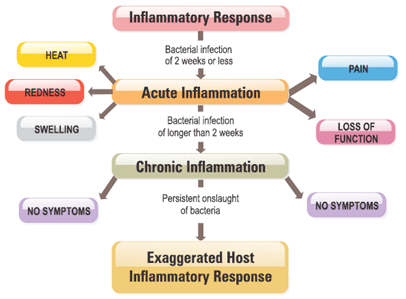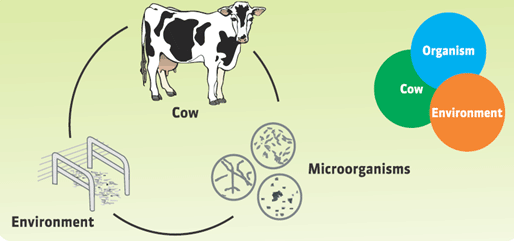Understanding Mastitis: From Perspective of Inflammation
Published: September 12, 2014
By: Dr. Zafar Ahmad & Dr. Divya Divakaran, Product Managers, Natural Remedies Pvt. Ltd, Bangalore
Inflammation and infection are among the commonest buzzwords in veterinary practice. The fact that inflammation appears to play a major role in many diseases makes it the fieriest topic of discussion nonetheless inflammation protects and heals the body after an injury or infection. Inflammation is an amazing process that, from the surface appears swelling and can hurt, but it’s all part of making things better. Mastitis, the most devastating inflammation of dairy animals causes huge economic loss to the dairy industry worldwide. An inflammation based understanding of mastitis opens the door for novel strategies in limiting the duration as well as cost of treatment.

The term inflammation comes from the Latin word, ‘Inflammatio’ which means to set on fire. The very purpose of inflammation is to burn away the harmful stimuli such as pathogens, allergens, injuries or any other irritants thereby initiate the healing response. However, just like fire, if inflammation is not extinguished then it can rapidly spread and beget more inflammation.
Acute and chronic forms of inflammation can be seen as inflammatory response based on the severity, duration, immune response and therapeutic intervention. Acute inflammation typically reveals all five cardinal signs of inflammation.
Mastitis is recorded as the most costly disease which affects dairy cattle throughout the world resulting in huge losses. In India it ranks second only to FMD in terms of economic loss to the country. Mastitis, inflammation of the mammary glands is the body response to defend against the invading microorganisms/physical agents into the mammary gland. Thus, the inflammatory reaction is something good but it may, unfortunately, also cause damage to the udder tissue. It is often affecting not only the mammary gland, but the whole organism systemically manifested by decreased appetite, depression, increased body temperature, and alteration of the whole metabolism. The economic consequences of bovine mastitis are colossal which include cost of treatment, production losses, reduced milk quality, reduced milk yield, increased culling rates and overall public health.
Mastitis is considered to be a multifactorial disease. Whilst over 200 microbial species have been identified as causative agents of mastitis. The major causes of mastitis are as follows;
- Bacteria (~70%)
- Yeast & Molds (~2%)
- Unknown (~28%) e.g. Physical trauma & Weather extremes

Risk factors for Mastitis
Mastitis is complex; there is no simple solution to its control. To simplify understanding of the mastitis complexity, it is useful to consider the three major factors involved in this disease:-
- Microorganisms (as causative agent)
- Cow (as host)
- Environment (which can influence both the cow and the microorganisms)
Development of Mastitis
Microorganisms penetrate the teat canal and multiply in the mammary gland leading to development of mastitis. It involves breaching of 3 lines of mammary defense mechanisms by the microorganisms to develop the disease.
First line of defense: Invasion of teat by microbes
Second line of defense: Microbial encounter by mammary localized leukocytes
Third line of defense: Destruction of alveolar tissue
Economic implications of Mastitis in dairy animals
Mastitis has been and continues to be recognized as one of the major disease problems concerning the dairy industry. The economic damage of mastitis, either clinical or sub-clinical can be brought down to a few categories:-
- Milk production losses: In both clinical and sub-clinical mastitis, there is a loss in milk production. Milk production loss in sub-clinical mastitis is not obvious to the producer, because this is milk never produced, and therefore never seen. It is a hidden cost or lost income opportunity.
- Drugs: This is a straightforward economic damage. Drugs, necessary to treat a cow with mastitis, cost money. The duration of treatment in clinical mastitis may vary from days to weeks to months.
- Discarded milk: Economic damage due to discarded milk is comparable with the damage of a decreased milk production. However, there is one difference; the discarded milk is actually produced by the cows, which means that feeding costs for that amount of milk has to be taken into account with the calculations. The economic damage of 100 kg discarded milk is therefore larger than for 100 kg decreased production.
- Veterinarian:Besides delivering drugs, the veterinarian might have to spend time on diagnosis of a (clinical) mastitis case or supportive therapy.
- Labour: Treating mastitic cows, while other cows are waiting in the milking parlour, is work that a farmer does not like to do. So (s)he is willing to spend money to prevent that.
- Milk quality:Mastitis influences the quality of milk. Some of these changes cause a less efficient processing of milk and might result in products with less favourable properties. Examples are an unstable and rancid taste of milk, a lower cheese yield and a decreased shelf life.
- Culling:Cows with mastitis have a higher risk of being culled. The cost due to premature replacement of animals due to mastitis is probably one of the largest areas of economic loss. However, it is also a hidden cost.
Potential Interventions
An inflammation-based understanding of mastitis opens the door for novel strategies in limiting the duration as well as cost of treatment. The complex interactions of stress, inflammatory cascades, and metabolic pathways allows for a broad array of potential treatments to prevent mastitis.
Knowledge of the causative agents, the milk production environment and the mammary gland as a reservoir, should be understood as a whole. These are the driving forces of the persistence and spread of the disease in the herd. Three pronged approach to mastitis including prevention of the disease by focusing on the reduction of new infection risk, the control of mammary gland state & the management of the existing clinical cases. All control tools should be developed to deal with the disease and finally to manipulate the immunity and to reduce the carrier state.
Despite world-wide efforts, mastitis has remained economically the most important disease in dairy cattle regardless of numerous mastitis control programmes in place it is still a major challenge for the dairy industry.
Related topics
Authors:
Join to be able to comment.
Once you join Engormix, you will be able to participate in all content and forums.
* Required information
Would you like to discuss another topic? Create a new post to engage with experts in the community.
Create a postPerry Brook Dairy Farm
26 de junio de 2019
Is there such a thing as injectable dandelion extract for fresh cows and injectable curcumin for our pre fresh cows?
Orffa Excentials
17 de abril de 2015
Congrats for the article.
Among the potential interventions, I would like to highlight the great role of cupper and zinc is udder health and disease to mastitis prevention.
Regards,
Alfredo.
9 de febrero de 2015
Hi Joe, I would like to refer you to our detailed article on mastitis in dairy animals published in engormix -Forum- sometime ago. Please go through it if you have any misconceptions let me know which we can discuss here. In fact mastitis is the major economical disease affecting dairying today and needs proper control measures.
Regards Jasmer Singh Ph D
9 de febrero de 2015
9/2/2015 M N B Nair .A combination of Aloe vera , turmeric and calcium hydroxide has worked wonderfully to cure any type of mastitis (sub-clinical, clinical and chronic) . The combination is antimicrobial, anti inflammatory and wound cleansing. field tested in 350 cases with 97% efficacy in three South Indian states. we have trained 150 veterinarians to use it the above result is the feed-back from them documented systematically. this can reduce the use of antibiotics substantially. This combination is cost effective, efficacious and reduce the use of antibiotics. There is no loss of production of milk and also can be used as preventive measure.
8 de febrero de 2015
Hi Linda, I would request you if the pH of the milk/any secretion from the udder is recorded with graded pH papers or a pen pH meter before and after the administration of garlic. Also please, If possible, could you manage to take some photographs of the inflamed udder, physical appearance of milk as to be bloody, watery or flakes etc., before and after the recovery. It will be nice observation and most useful for others in the business.
Regards Jasmer
8 de febrero de 2015
Hi Linda, I hope you might have procured the salt Trisodium citrate. Please let me know o that we can make a schedule for the control of mastitis in your goats at the farm.
Regards Jasmer
13 de enero de 2015
Hi Linda , Please let me know when you lay hands on trisodium citrate so that we can plan control measures against MASTITIS in your herd of goats.
Jasmer Singh Ph D
11 de enero de 2015
Hi Linda, I gave you the link earlier in this thread on 12.24.2014 from where Trisodium citrate can be procured i.e,. amazon.com and you inquired about its quality etc. It is available in different packs as 1lb 2lb, 5lb ,25lb and 50lbs and you can get it by just ordering Amazon (in USA). Any other problem please do inform me.
Jasmer Singh Ph D
10 de enero de 2015
hi
Hi Linda, You have rightly pointed out regarding the balancing process of various minerals and other nutritional ingredients propounded by Dr Lester. He is also right in saying that "mastitis is a man-made-disease". However,it is easier said than done to regulate such balances simultaneously in at least two biological systems-soil and animal systems. To be more practical there is nothing to be intriguing regarding mastitis control with Trisodium Citrate, since its deficiency is the basic cause as evidenced by published clinical field trials in reputed scientific periodicals and its replenishment easily cures clinical/subclinical/chronic cases of this malady without any side effects. The most crucial aspect of mastitis control on a dairy farm is to monitor the pH of milk with graded paper strips or a pen pH meter and citrate with available kits. These two methods are very economical and easy to operate on the farm.
Jasmer Singh Ph D
6 de enero de 2015
Hello Dr Nick, As I have stated already that synthesis of Citrate in udder/breast is independent of the body metabolism, hence, any defect in its synthesis would result in its deficiency in the udder. The main function of citrate in udder is to keep Ca2++ sequestered ( citrate remains bound to Calcium) and maintain the pH of udder. For instance the pH of Calcium itself is ~10 hence , free calcium also might add to raise the udder pH. Calcium per say is obtained from blood for the synthesis of milk. Therefore, the initial injury inflicted by Free Ca2++ causes swelling-not inflammation and this swelling appears to cause the leaking of tight junctions followed by the swapping of ions like Na, K, Cl, Hco3 etc., which raises the pH of the udder. The injured site later is infected by environmental organisms e.g., Strept., Staph, E coli etc which triggers the body defense mechanisms resulting in infectious mastitis and inflammation due to mainly polymorphs and macrophases etc.
Jasmer Singh Ph D






.jpg&w=3840&q=75)





.jpg&w=3840&q=75)